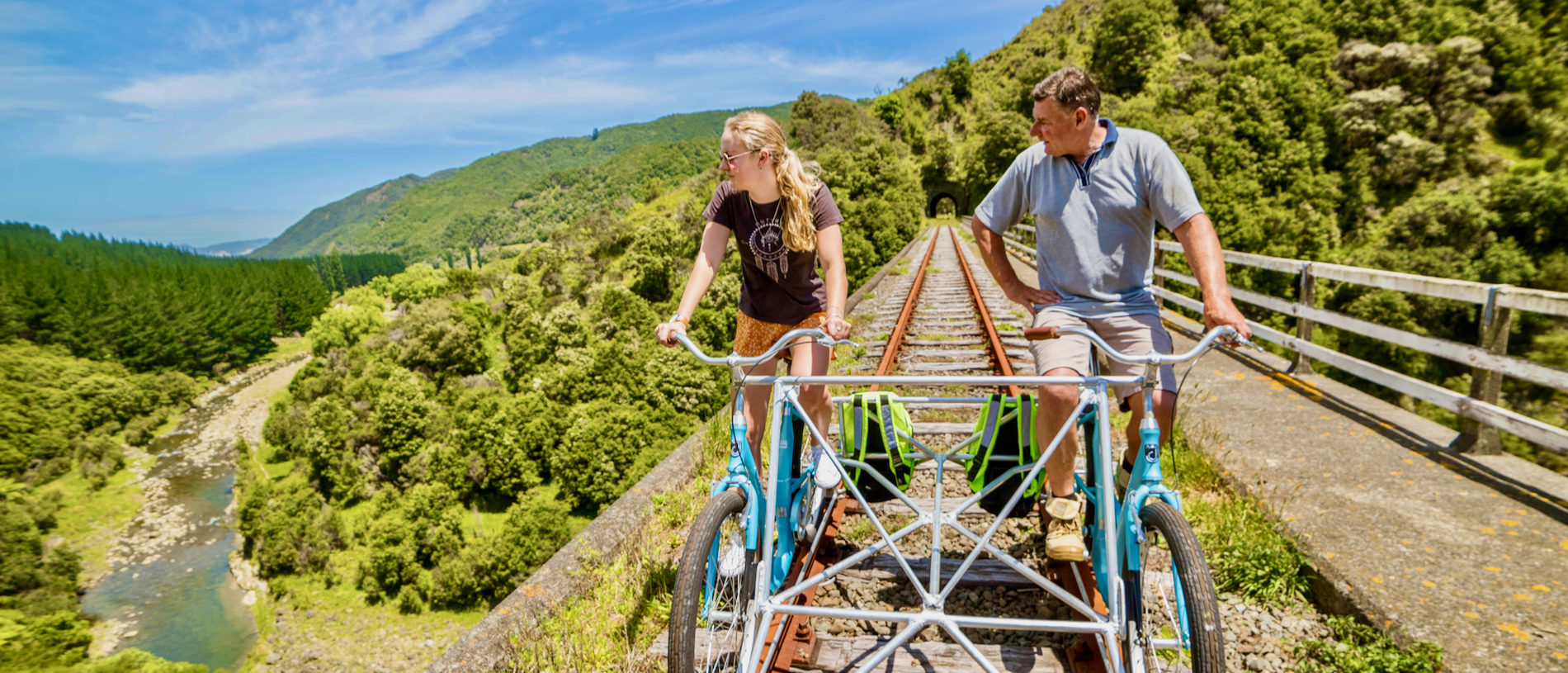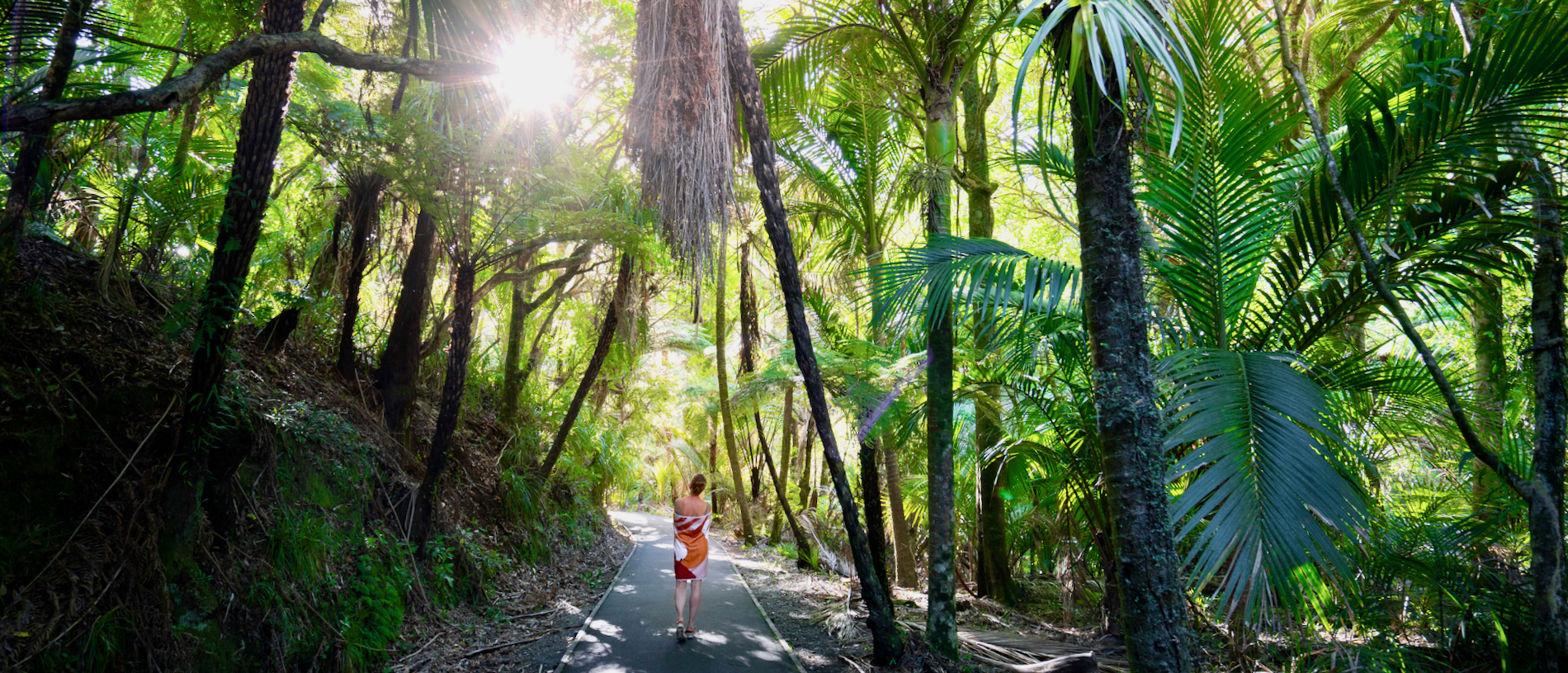
Take to the rails on a Gisborne Railbike Adventure
Just outside Gisborne you can cruise along a coastal railway line – by bike.

There's much more to the East Coast than just the famous vineyards and beaches. Find great cycle trails, hidden hot springs, Māori history and New Zealand's largest pōhutukawa tree amongst these 10 Kiwi Gems in Hawke's Bay and Eastland.
Not far from the easternmost point of the North Island you’ll find Te Waha o Rere Kohu – the largest pōhutukawa tree in the world. Growing in the grounds of Te Waha O Rerekohu Area School at Te Araroa, the tree is estimated to be more than 600 years old, with a branch span stretching more than 40 metres. Te Waha o Rere Kohu means ‘the mouth of Rerekohu,’ which refers to the time when the tree was used as a whata-kai, a place where food was dropped off. Best visited in early summer to experience the full glory of its radiant red blooms.
Inland from Ruatoria on the East Coast, Mount Hikurangi is the highest non-volcanic peak in the North Island and the sacred maunga of local iwi, Ngāti Porou. Standing at a majestic 1,754 metres, the mountain is an incredibly spiritual spot to catch a sunrise. To truly experience the beauty, history and cultural significance of this area, take a 4WD tour with the team at Ngāti Porou Tourism. Crossing farmland before dawn to reach the nine breathtaking whakairo (carvings) that tell the stories of the maunga, you’ll be in prime position to be the first in the world to welcome the new day.
The 103km, Grade 3 Rere Falls Trail that winds through remote countryside inland from Gisborne takes between one to three days to complete. But you won’t want to rush, as there’s plenty to do along the way. It’s best to begin this trail at Matawai to enjoy the long descents as the alternative requires some serious legwork. The Rere Falls Trail, of course, takes in its namesake – the famous waterfall and rockslide, as well as the beautiful Eastwoodhill Arboretum where you can stop and admire the magnificent exotic trees. Towards Gisborne, the flat Tairāwhiti River plains are home to the region’s finest wineries, so allow plenty of time to explore these, too.
In Te Reo, Waikareiti means ‘little rippling water,’ likely in reference to its location next to the much larger Lake Waikaremoana ‘the sea of rippling water.’ This small lake in Te Urewera is reached on an hour-long walk through gorgeous red and silver beech forest that’s home to native kākā and kākāriki. The most remarkable thing about Lake Waikareiti is its incredible water clarity. Formed by a massive landslide more than 1,800 years ago, the lake is crystalline, with a pale sandy bottom, and is popular for trout fishing. The track to reach the lake begins about 200m from the visitor centre. While you’re there, head a little further up Aniwaniwa Road to see the impressive Papakorito Falls.
Soak in serene hot pools surrounded by beautiful nīkau palms that lend a tropical island vibe. Mōrere Hot Springs 50km south of Gisborne are unique in that they are one of the only places in the world where you can immerse yourself in hot salt water. The springs produce 250,000 litres a day of ancient heated sea water emerging through a fault line. At Mōrere Hot Springs, ease yourself into a private hot pool or head to the palm-fringed Nīkau Pools and soak up the natural ambience. While you’re here take an easy amble through the dense forest on trails that range from 10 minutes to several hours.
Travel back in time at the Faraday Museum of Technology in Napier. A treasure trove of vintage machinery, communications and entertainment, the museum is a hands-on experience designed for visitors to immerse themselves in the technologies of yesteryear. Pull levers, push buttons, explore the power of pedalling or play the pianola to learn how previous generations made things work in the days before digital technology ruled.
In Hawke’s Bay’s Kaweka Forest Park you can experience natural hot springs in a lush bush setting, for free. The Mangatutu Hot Springs are found overlooking the Mōhaka River down a short, steep track from the Department of Conservation campsite. Warm thermal water is piped into two well-made pools and you can adjust the temperature by adding fresh water to the mix. Getting to the pools is an adventure involving an hour of driving on gravel roads and fording a river, so don’t attempt a trip after heavy rain.
A short drive from Havelock North Village in Hawke’s Bay will take you to one of the region’s best summer swimming spots – Maraetōtara Falls. From the carpark, take the wooden stairs and follow the walkway for about 10 minutes to reach the base of the falls. Once you’ve had a dip in the picturesque swimming hole, continue on the Maraetōtara Historic Walk where you can discover the old turbine house and surge tower, relics of the former Havelock North Power station.
New Zealand’s most famous redwoods forest is in Rotorua, but Hawke's Bay is also home to its very own own spectacular collection. In Te Mata Park you’ll find a grove of 223 Sequoia sempervirens, California redwoods planted in 1927. Recorded as the tallest trees on earth, the largest specimen – Hyperion – in Northern California measures an astonishing 116m. While the redwoods in Te Hau Valley at Te Mata Park are babies by comparison at just 40m, they still make for a photogenic outing and lovely picnic spot. To get there, park by the main gates at the base of Te Mata Peak and follow the one-hour, 2.7km Big Redwoods track for the most direct route.
On a hilltop in Central Hawke’s Bay’s Waipukurau you can discover the stories of the region’s past in a new interactive experience using traditional carving and digital media – Ngā Ara Tipuna. On the former site of the Pukekaihau Pā, storyboards reveal what the landscapes here used to look like 400 years ago. Once a flourishing wetland and pā settlement, this part of Central Hawke’s Bay was a bustling hub for Māori, and many of the region’s important tīpuna (ancestors) lived in this sprawling hilltop pā tūwatawata (fortified settlement) during the 1600s. Ngā Ara Tipuna has been created by mana whenua to preserve the area’s unique stories and knowledge for future generations.